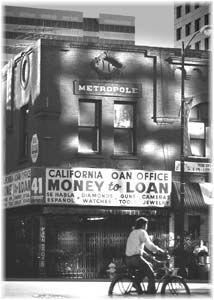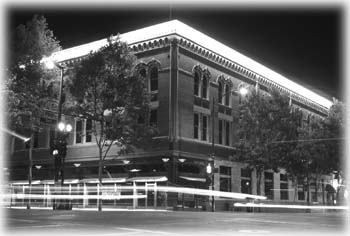The Valley's Great Saves
Older buildings provide a connection to the history of a place. But in a valley busy chasing the future, historic architecture is a finite and dwindling resource. If a vibrant civic culture is to evolve in Silicon Valley, historic buildings will be part of it. Not just the landmarks, but the workhorses that serve as living parts of our past and present. Here are some of the historic buildings that were brought back from the dead and are here to stay.
![[line]](/gifs/line.gif)
Another historic save: Medical-Dental Building
![[line]](/gifs/line.gif)
Twohy Building
1917
200 S. First Street, San Jose
T.S. Montgomery built this ornately detailed five-story steel-framed office building across from the Montgomery Hotel. Its highly polished terra cotta facade was mimicked by the Sainte Claire building down the street. It was built as office space for San Jose's burgeoning professional class: doctors, lawyers, dentists and watchmakers.

Metropole
Hotel
1890s
35 S. Market St.,
San Jose
Once a working-class hotel and later a pay-by-the-month flophouse, the old Metropole will open again next year in its third incarnation: as "swanky" office and retail space. Built by the de Saisset family as the Alcantara Building, it was designated a historic landmark in 1989. But the hotel itself was built on some of San Jose's most hallowed ground. Almost two centuries ago, the Pueblo of San Jose's first public building, or juzgado, was built on the site in 1798. It was over this building on July 14, 1846, that one of Capt. Thomas Fallon's men raised the American flag for the first time in San Jose.
Sainte Claire
1926
302 S. Market St., San Jose
Built and furnished for $1 million, when it opened, the Sainte Claire was the biggest, fanciest hotel between San Francisco and Los Angeles. It unseated the Montgomery Hotel as San Jose's most prestigious landmark and was symbolic of T.S. Montgomery's effort to pull the cultural and commercial center of San Jose to the south. A decade later he donated the land for the San Jose Civic Center across the street. The Sainte Claire fell on hard times in the '70s, but was brought back from a flophouse in the early 1980s by Stephen Lin and ultimately restored in 1992 by the Mobedshahi Group.
De Anza Hotel
1931
233 W. Santa Clara St., San Jose
When it opened in the midst of Prohibition, the deco De Anza took its place next to the Sainte Claire as one of San Jose's two finest hotels. But as the Sainte Claire appealed to the conservative and established, the De Anza drew the young, rakish and rich. T.S. Montgomery, owner of the Sainte Claire, didn't approve of alcohol. After Prohibition, the Danzabar opened inside and made the hotel the hottest nightspot in San Jose. It was built for $161,500 by Carl Swenson and restored almost 60 years later by grandson Barry Swenson and developer Jim Fox.
Eugene Votzenlogel's
Saloon and Bath House
1873
65 Post St., San Jose
Quite possibly the oldest standing commercial building in San Jose, the saloon was once the center of the city's debauched frontier life. The street's name was later changed from El Dorado to Post Street in an effort to clean up its image. The saloon was called Billy Finley's in the '50s, until Billy fell out a window during St. Patrick's Day festivities in San Francisco in 1956. This year, the Italian Ornate saloon got a new lease on life as Waves, a barbeque restaurant and bar. Owners Joel Wyrick and Judy Pearson poured in $1 million "for the love of that building" to preserve a bit of San Jose history. They've even preserved a section of the marble spittoon that once ran the length of the bar. Under the plexiglass is authentic frontiersman saliva.
Berryessa Adobe
1840s
373 Jefferson St., Santa Clara
Thirty years ago Santa Clara had a historic downtown that historian Lorie Garcia says "would make Los Gatos whimper." Then came urban renewal's bulldozers. Now, preservationists scramble for what's left. The city just purchased Berryessa Adobe, the only residential adobe from the mission period in mint condition.
Letitia Building
1890
68 S. First St., San Jose
Named for the daughter of California's first governor, Letitia Ryland Burnett, the building is owned and slated for restoration by Barry Swenson. Outside, the Romanesque facade has been defaced by '60s storefronts. Where a bit of the facade has fallen away from its rebar, the top of a recessed corinthian column is visible. Inside, the building is lighted by an airy inner atrium.
County Courthouse
1866
161 N. First St., San Jose
The corinthian-columned courthouse was overbuilt for a reason. San Jose lost the state capital in 1851, so the city built a capitol with an extravagant dome in hopes of attracting it back. In 1931, it was gutted by fire, and the dome's copper lining melted and ran down the front steps. It was rebuilt with the columns recessed and the dome replaced by a third story. Today, the courthouse is the focal point of St. James Park and a fine example of the lasting power of an ambitious building designed to be a landmark.

Security Building
1892
84 S. First St., San Jose
This beautifully restored brick-and-sandstone three-story building typifies the character of old downtown San Jose as much as any. One can almost imagine the horses tied up outside. Restored by Barry Swenson, the upper floors are empty and awaiting tenants. Incredibly, many of the strategically located first-floor retail spaces are also empty. Inside the building, there are intricate moldings and exposed brick. Interior light wells pierce the two floors, bringing daylight to the offices below.
Scheller House
1904
SJSU Campus, San Jose
Queen Victoria died in 1902. So Victor Scheller, who served as district attorney of San Jose at the turn of the century, missed his chance by two years to build a true Victorian. This old white bungalow on the San Jose State campus is called Colonial Revival instead and is typical of the early California traditional style. The Preservation Action Council filed suit in 1995 to stop the university when Acting President J. Handel Evans wanted to tear the house down for expansion of the science building and a plaza. Now the alumni are raising money to have it restored. Until then, the old house sits, wood rotting and windows broken.
Peralta Adobe
1777
184 Sainte John St., San Jose
Listed with the city as Historic Landmark No. 1, this is the last remaining adobe of the Pueblo of San Jose, California's very first civil settlement. When it was built, there were 13 states, and California was part of Spain. Need we say more?
Casa Grande
1852
21350 Almaden Road, Almaden Valley
Built during the Almaden mining period, Casa Grande housed Union soldiers sent here by President Lincoln to protect the mines during the Civil War. The two-story brick structure was, when it was built, the largest building in California. The County of Santa Clara is in escrow on the big Casa--they want to make it into a museum.
Alviso Adobe
1830s
Piedmont Road, Milpitas
The poor old couple who used to live here put plywood over the windows to shut out gawkers and history buffs. Built by Jose Maria de Jesus Alviso, the adobe has always been used as a private home and is in incredibly good shape. Once it clears escrow, it will belong to the city of Milpitas.
Roberto-Sunol Adobe
1836
770 Lincoln Ave., Willow Glen
It almost became the shoulder of Highway 280, but good old Leonard McKay and some friends convinced Caltrans to put a 15-foot curve in the road. The house contains a collapsible rocking chair that came over the Sierra with the Donner Party. In the back yard is San Jose's oldest known living fruit tree--a 161-year-old black fig.
Hayes Mansion
1905
200 Edenvale Ave., Edenvale
The three-story Mediterranean-style villa was built with 19-inch-thick brick walls with good reason. It was built to replace Mary Hayes-Chynoweth's first mansion, which burned to the ground in 1899. Hayes Chynoweth's sons, Everis W. Hayes and Jay O. Hayes, bought and merged the San Jose Herald in 1900 and the Mercury in 1901. When the paper began to falter in the 1940s, their sons, Elystus L. Hayes and Harold C. Hayes, took over, bought the Evening News in 1942 and created the Mercury News. The city of San Jose rescued the Hayes Mansion from the steady march of condominiums in 1985. Now it serves as a conference center.
Paul F. Clark House
1915
1147 Minnesota Ave., Willow Glen
Built for Paul Fenimore Clark, who became the first mayor of Willow Glen in 1927. A signature example of architect Frank Wolfe's work, the house was saved from condominiums when it was purchased last year by Live Oak Adult Day Services. Considered by the San Jose Planning Department as a "contributing structure" to community history, the house is slated for renovation. Live Oak plans to use the old house for administrative offices and build a new adult-care facility on the property.
[ Metro | Metroactive Central | Archives ]
![[Metroactive Features]](/features/gifs/feat468.gif)
![[Metroactive Features]](/features/gifs/feat468.gif)